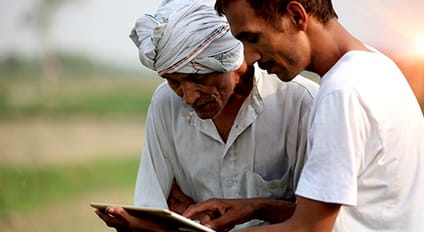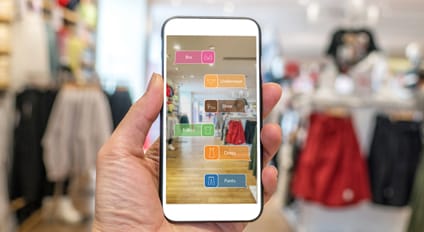Get Focus insights straight to your inbox
Covid-19 catalysed a lot of changes that were already happening in the world, and nowhere is this more evident than in the TMT space. In the latest Deloitte TMT Predictions 2021 report, nine global TMT trends are identified, and the Investec Focus team has selected the four that are most applicable to South African businesses, namely: gaining an intelligent edge, the rise of 5G, Cloud migration and virtual medical consultations.
Prediction #1: The intelligent edge will come of age
It’s already transforming some of the world’s largest technology and communications companies, but 2021 will be a breakthrough year for the growth of intelligent edge computing.
“Intelligent edge is the analysis of large volumes of data and the development of possible solutions at the point where the data is generated,” says Reagile Moatshe, Head of Supplier Finance at Investec Corporate & Institutional Banking.
Moatshe adds: “This is different to scenarios where the data is first aggregated at a data centre and solutions are devised and then re-transmitted back to the company.” In a nutshell, intelligent edge means faster, less expensive and more secure operations and therefore increased business efficiency.
Deloitte predicts that in 2021 the global market for the intelligent edge will expand to US$12 billion, with an annual growth rate of 35%. Their report gives the following reasons for this impressive growth trajectory: “Expansion in 2021 will be driven primarily by telecoms deploying the intelligent edge for 5G networks, and by hyperscale Cloud providers optimising their infrastructure and service offerings.”

Telecoms are a central node through which large volumes of data – voice and content – is transmitted between parties. Through ongoing investment in the infrastructure, the quality of the network is enhanced thereby ensuring that large volumes of data can be analysed and transmitted seamlessly.
Looking ahead, intelligent edge will be vital for businesses that are generators of large volumes of data at industrial scale, or those that have repeated processes at scale such as volume manufacturing, information processing and logistics.
Where edge networks can be deployed
In their article “Unbundling the cloud with the intelligent edge”, Deloitte gives several examples of how edge computing is drawing on other Industry 4.0 technologies to help companies quickly act on data close to where it’s captured.
Reduced latency
“Edge networks can dramatically reduce latency – the time between an input and a response – critical for applications that require high-speed or real-time response, such as autonomous vehicles, drones, or industrial cobots operating alongside people in unpredictable environments" - DeloitteDetecting employee fatigue
The edge can be used to detect tiredness in long-distance truck drivers. In-vehicle devices monitor the driver’s pupil dilation to detect fatigue. Immediate response times are key here, with control centres being able to call tired drivers to get them to pull over and take a break.Healthcare
Using Edge computing architecture and AI in medical cameras, doctors can screen patients for diabetic eye disease, a difficult-to-diagnose condition that can result in blindness if not detected early. Technology from Taiwan-based med tech firm NVIDIA allows doctors to generate a diagnosis in seconds.Agriculture
Hewlett Packard Enterprise is working with farms in India to increase crop yield, nutritional value and revenue. “Twenty-seven sensors capture data on irrigation, soils, seeds, and weather, along with drone imaging analysis. The data is then integrated into their onsite Edge appliance that can model yields, make predictions, and send updates to connected equipment.”Prediction #2: 5G won’t affect anyone’s health
As the use of 5G ramps up, so too does controversy around the technology. The Deloitte TMT report predicts that in 2021 between 10% and 20% of adults in many advanced economies will mistakenly equate 5G with possible harm to their health.
The two most common misconceptions are that 5G causes cancer and that it is somehow connected to the spread of Covid-19. We asked Paul Lee, Deloitte Global Head of Research for the TMT industry, for his take on the 5G-Covid-19 myth.

There’s been a mis-association of 5G with the spread of Covid-19: last year saw the roll out of lots of 5G base stations around the world, and we also saw an increase of Covid-19 infections. One erroneous view is that 5G-emitted radiation causes the immune system to weaken; another, which is impossible, is that Covid-19 is spread via 5G base stations.
Deloitte’s prediction for 5G? “We predict that in 2021, it is very unlikely that the radiation from 5G mobile networks and 5G phones will affect the health of any single individual”.
Despite this, sceptics abound. In the UK by April 2020, more than 50 incidents of arson or vandalism on wireless towers had been recorded. The trend continued throughout Europe, and in South Africa, as recently as January, three cellphone towers were set alight in KwaZulu-Natal.
5G connectivity globally
93%
10%
24.4%
76%
Moatshe says these conspiracy theories are contributing to the delayed roll out of 5G in South Africa. The auction of spectrum [wireless radio airwaves by which information is transmitted] is supposed to take place in March, but is being delayed because of this misinformation and squabbles between mobile network operators.
“The regulator needs to take into account public perception and has an obligation to go back and prove whether those perceptions are in effect reality or not," explains Moatshe.
Adding to further delays to the entrenchment of 5G in South Africa is the battle for spectrum that is playing out in the courts between The Independent Communications Authority of SA (ICASA) and the various mobile network operators, who all have their eye on the ultra-fast 5G radio frequency spectrum. The fight is over the bidding criteria that ICASA wants to use in the auction.
“The end intention is that very large mobile network operators have to stand further down the queue and allow the smaller operators to have first right to bid,” explains Moatshe. “But then aren't you prejudicing key operators that are essentially carrying the majority of mobile users of this country?”
READ MORE: 5G: The next wave of tech disruption
Here are just some of the innovations that 5G has enabled
Queue-less shopping
In this tech-forward convenience store, sensors, cameras and deep learning algorithms are used to scan and tally up items as shoppers take them off the shelves. Payment is automatically deducted as you leave via a virtual card and the Amazon app. This technology is all underpinned by 5G which ensures the speed, reliability of connection and lack of drop-out to ensure a seamless customer experience.Virtual dressing rooms
As shopping centres seek to match the online experience in store, the use of 5G-enabled virtual or augmented reality will become commonplace. Imagine standing in front of a shop mirror “trying on” clothes and getting automated recommendations on how to complete the look? And if you like it, simply buy it there and then by tapping the mirror display.Smart factories
Ericsson’s USA 5G smart factory based in Texas uses 5G for AR maintenance, providing teams on the ground with virtual guidance from experts to perform any repairs. It also uses drones for inspection and has automated unpacking processes.Smart ports
The Port of Qingdao in China, one of the world’s top ten busiest ports, and has the first fully-automated container terminal that uses hydrogen energy and 5G technology to remotely operate cranes. In its trial phase, 70% of labour costs were saved.Prediction #3: The Cloud comeback will continue
We all use multiple types of cloud-based applications on a daily basis, from sending files via WeTransfer to bingeing on Netflix, storing files on OneDrive and SharePoint and even playing online video games. The Cloud is simply the storage and accessing of data and programmes over the internet, and not locally on your computer’s hard drive.
From triple-digits, the growth of Cloud technology had dropped to double digits before the pandemic struck. Then came 2020 – an unprecedented year on all accounts. Due to the Covid-19 pandemic, many businesses were forced to rework processes, rapidly implement business continuity plans, and exponentially grow the use of remote technology as employees could not physically be in the office. Business became virtual overnight.
“All of a sudden people couldn't go to the office but still needed access to data, so business continuity plans that were never finalised were quickly pushed through,” says Moatshe. “This drove the 40% growth rate in the year-on-year adoption of Cloud - one of the largest and fastest growth rates in the adoption of a technology.”
The TMT Predictions 2021 report notes that cloud spend is now growing faster than overall IT spend. “We're expecting US$160 billion in cloud revenue in 2021 – a big jump from 2020, and we’re expecting that kind of growth to continue through to 2025,” says Lee.
According to World Wide Worx in their report Cloud in Africa 2020, 82% of IT decision-makers in South Africa increased their cloud services spend last year. More stats from this report are featured below.
2020 Cloud spend in South Africa, according to surveyed IT decision-makers
93%
45%
34%
Another trend picked up by the TMT report is the adoption of hybrid cloud solutions, something that Deloitte predicts 90% of global enterprises will rely on by 2022.
“The concept of hybrid Cloud is a mix between public and private Cloud,” explains Moatshe. “Not all data generated by business holds equal weight from an importance and/or regulatory perspective. Business-critical data is often stored on a private Cloud, while other data is generally stored on a public Cloud."
Prediction #4: Virtual doctors’ visits are here to stay
Video consultations with doctors became commonplace during the pandemic and this is a trend that will keep on growing, finds Deloitte, whose report predicts that the percentage of total visits to doctors that are done virtually via video will rise to 5% globally in 2021, up from 1% in 2019.
Furthermore, the market for pure-play telehealth virtual visit solutions will reach US$8 billion in 2021, and that this will spur sales of over US$33 billion of medical-grade home healthcare technology (mainly therapeutic and monitoring solutions) this year, a 20% increase over 2019.
The telemedicine trend is also being spurred by the fact that the number of devices and connections are reaching critical mass globally, especially among the elderly. Imagine the potential of telemedicine in Sub-Saharan Africa for example where mobile Internet users are set to grow from 272 million in 2019 to 475 million in 2025, according to a GSMA report on the mobile economy.
So, video visits could be big business in the future, but does it take away from the human touch of face-to-face visits? Not so, says Dr Sihle Asiedu-Darkwah, the founder of Prime Medical Solutions – the first ever virtual and medical mobile practice in South Africa that opened its doors in 2020 when the Covid-19 pandemic first struck.

I don't think virtual doctors' visits take away from that human touch of medicine. Firstly, because not all ill health is physical so some medical conditions will never warrant a physical examination. The history-taking aspect, or the interview aspect of a consultation is really probably one of the most important aspects of consultation for us as healthcare providers.
The TMT Predictions report notes that although the idea of tele-health is gaining popularity among patients, for the industry to truly grow, it will require buy-in from health professionals, insurers and regulators.
“Virtual healthcare, tele-health, is here to stay. The convenience is undeniable, and I think as more patients start to access healthcare virtually, doctors who aren't able to fit their service offerings in line with that, will actually be lagging behind their patients’ expectations. There's no going back, this is the future of healthcare and it's going to continue to evolve, and any healthcare workers or healthcare providers who don't recognise it now and move with the times will definitely be left behind,” warns Asiedu-Darkwah.
TMT beyond Covid-19
Some of this year’s predictions have been influenced by how the world has changed due to Covid-19, but what will happen post pandemic? The truth is that no one knows, but by implementing technologies like intelligent edge, Cloud computing and 5G, businesses will be able to adapt quickly to whatever the future holds.
About the author

Lenyaro Sello
Digital content specialist
Lenyaro is a key member of Investec's Global Content team, based in Johannesburg, who focuses on relevant and topical issues for internal and external audiences including clients. She is a well-travelled multi-skilled multimedia journalist who previously held roles within eNews Channel Africa (eNCA) and Eyewitness News (EWN).












